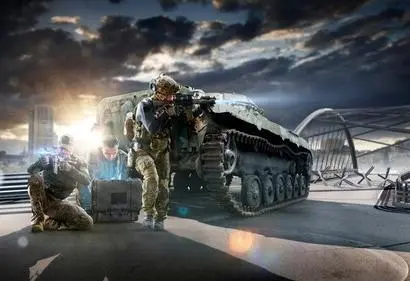Abstract: Emerging technologies and their cognitive aspects influence the operational planning process; thus, operational planning can become more efficient if planners adopt a multi-disciplinary approach. Such an approach must go beyond the standard PMESII framework (Political, Military, Economic, Social, Information, and Infrastructure) and consider other domains, such as those in the PMESIIIR&T framework. Military planners must follow the evolution of technology in conflict/war/operations, especially when employing different instruments of power.
Problem statement: How is the operational planning process affected by new technologies and the interconnections between the agencies, levels, domains, and dimensions?
Bottom-line-up-front: Today, the operational planning process and intelligence preparation must be multi-disciplinary. This is urgent as new technologies and cognitive aspects impact the balance between various levels of command.
So what?: Operational headquarters must approach the intelligence preparation of the operational environment with a new standard, moving from the PMESII to PMESIIIR&T. The PMESIIIR&T (Political, Military, Economic, Social, Infrastructure, Information, Info-Data Structure, Research & Technology) framework relates to the evolution of ongoing conflicts/wars/operations. Any action, effect, or decisive condition reached during a campaign may generate effects across and among domains. Therefore every single domain is interconnected and affects many dimensions (multi-domains), different levels of operations, and multiple military and non-military-stakeholders.

Source: shutterstock.com/Thomas Andre Fure
PMESII – What Else?
The ongoing competition between the US and revisionist powers such as the People’s Republic of China, the Russian Federation and Iran occurs across multiple domains, reaching from diplomatic efforts via economic measures to information wars and concerted geoeconomic deeds. Indeed, ongoing conflicts can be defined as multi-level, multi-domain, inter-agency, and multi-disciplinary events.[1]
In NATO, when a theatre is studied from a military planning point of view, it is analysed according to the PMESII domains.[2] However, it is questionable whether this analytic method is still valid in a perpetually accelerating world. These domains must be integrated with newer ones since they no longer fit the times. In the new era, more than ever, not only the speed of access to information but, above all, the analysis of the same plays a fundamental role, and this advantage can only be obtained through technological supremacy over the other competitors. Compared to the past,e.g., submarine infrastructures are essential assets and must be physically protected, just think of how underwater internet cables transmit information, ranging from the financial to the social field and which connect the whole world. Case in point, one should start talking about PMESIIIR&T, meaning Political, Military, Economic, Social, Infrastructure, Information, Info-Data Structure, Research & Technology.
Leaving aside the elements already known and explained in the NATO publications,[3] it is appropriate to consider the Info-Data Structure, Research and Technology (IR&T) domains. Including info-data structure analysis of a theatre is advisable because info-data structures represent vital connectivity hubs in today’s interconnected world. They cannot be compared with typical critical infrastructures, such as roads, ports, and bridges. However, in a particular theatre, it might be necessary to understand which underwater cables are fundamental and where their vital data servers are located. These info-data structures differ from others because they can be physically neutralised, not only by kinetic means but also by non-kinetic effectors or cybernetic action—or even stolen. Info-data structures are represented by internet servers, cloud infrastructures, submarine cables (internet, energy), and pipelines.
Leaving aside the elements already known and explained in the NATO publications, it is appropriate to consider the Info-Data Structure, Research and Technology (IR&T) domains.
The technical advantage is fundamental to maintaining or achieving awareness of the operational environment. This sector is transversal to all the others and must be considered. By now, technology is omnipresent, from the military to the economic-financial and health domains as well as the social ones. The latter opens the doors to another spectrum that ranges from the cognitive to the social dimension.
In simple terms, commercial technology could be misused by armies. Just look at the disastrous employment of the Russian Army in Ukraine during the first days of the invasion. It resulted in what can be defined as precise digital targeting of generals and infantry personnel communicating with each other to coordinate simple transfer actions.[4]
The Russian war in Ukraine is also characterised by new technologies such as drones, maritime and air, and state-sponsored private enterprises, such as Starlink.[5] A principal benefit of these new technologies is found in the automation of unmanned vehicles, which can be operated without human input, making them even more versatile. There are various ways to automate drones using Artificial Intelligence (AI). One common method, for example, is using GPS coordinates to program the drone’s flight path. AI is being adopted at such a large scale due to its capacity to automate previously impossible or solely human-driven tasks. This, coupled with the technology’s ability to automate repetitive processes, makes it a highly disruptive power in various sectors.
A principal benefit of these new technologies is found in the automation of unmanned vehicles, which can be operated without human input, making them even more versatile.
Therefore, future wars could be fought using artificial intelligence, the metaverse, and the integration of autonomous and non-autonomous systems, as all these assets and disruptive technologies allow an operator to gain a technological advantage over its opponents. As a rule of thumb, the technological power could be summarised as follows: AI + Big Data + High-Speed Computing + the ability to integrate different systems (unmanned and manned) and damage assessment in real-time (physical and cyber) = Technological Power.[6]
In the future, it will be necessary to predict an opponent’s moves; thus, it would be essential to understand how the other forms of artificial intelligence work.[7] The necessity of this understanding will be driven by the fact that different definitions of AI are caused by variations in the cultures of countries developing it. For these reasons, it might be essential to establish research centres to identify the possible algorithms to predict possible courses of action that involve the “machines”. Such analysis must be contextualised: one must study a theatre’s history and culture and understand its centre of gravity and strategic interests to predict such behaviour.[8] The study of technology and data facilitates this approach to enhance the decision-making process.
DIME+?
New domains imply the necessity to use new instruments of power, which the old acronym DIME can merely explain: Diplomacy, Information, Military, and Economy. DIME must include at least two new instruments: “Cognitive and Technology” (DIMECT). The cognitive dimension has characterised all the modern hybrid conflicts, multi-dimensional and multi-domains by design, which affect all the substrata of society. It is enough to think of how perception can be influenced or modified by effective communication spread on social networks and through standard communication systems.[9] Through social networks, civilians are persuaded and fed with the hope of success. Battlefields are nowadays physical and virtual, whereby civilians are employed in “tracking” enemy troops on them. The new cognitive and technological instruments of power are directly linked to modern social media platforms, battlefields and spaces of engagement. As such, new domains should be handled using new instruments of power, with a revolutionary approach that goes beyond traditional ones like air, land, and maritime.
DIME must include at least two new instruments: “Cognitive and Technology” (DIMECT).
Technological and cognitive aspects seem to be strongly linked to the Electromagnetic-Spectrum,[10] in which new competitors have started investing, researching and developing strategies. The electromagnetic spectrum is a space of engagement vital to defeating enemy critical capabilities and effectively acting within the cyber domain. The electromagnetic spectrum domain has a range of applications and uses that cover the ground, maritime, air, space, and cyber domains. Deductively, it has created new frontlines of offence and defence in contemporary warfare; thus, it is necessary to grant superiority in the electromagnetic spectrum domain to deter and conduct cross-domain operations.[11]
To gain awareness in each of the six military domains (5 NATO recognised domains + Electromagnetic), it is crucial to develop a strong C7AISTAR capability (Command, Control, Communication, Computer, Cyber, Combat/Engine System, Cognitive, Autonomous System, Intelligence, Surveillance, Targeting Acquisition and Reconnaissance). This would grant the capability to plan and conduct military operations in all spectrums, ranging from disaster relief to warfighting. To adopt the C7AISTAR, we should seek to integrate new technologies and systems and develop new layers of data and functional coordination.
The C7AISTAR is an evolution of C5ISTAR (Command, Control, Communication, Computer, Cyber, Intelligence, Surveillance, Targeting Acquisition and Reconnaissance) obtained with the implementation of new technologies in military assets. In the new framework that the writer proposes, the first new element is the “combat/engine system” because new military assets are more interconnected than in the past. Connectivity is an advantage. Nonetheless, it hides pitfalls such as cyber-attacks and electronic warfare measures, which is why it is necessary to protect military networks from cyber attacks. The second new element “is the cognitive aspect”. This instrument of power requires a more comprehensive approach as it involves a robust information security policy to prevent sensitive data from being compromised, correct/proper use of social networks jeopardised by modern technology and the extensive use of smartphones, and a strategic communication policy to influence enemy thinking and decision-making processes actively.
The third and last element added, the “autonomous systems,” changes how we wage war. Although the central role of autonomous systems and drones has focused mainly on ISR and artillery spotting in the last two decades, ongoing conflicts have fully implemented autonomous technologies. Nowadays, autonomous systems carry out different war functions such as targeting and striking (bombing – missile launching, torpedo launching) and are primarily used as active assets. Plus, the forces that deploy them claim to minimise the loss of life and be able to operate in areas where human exposure would be considered an unacceptable risk. While military superpowers once monopolised combat drones, this is no longer the case. Today, autonomous systems are used by non-state actors, such as insurgents, for example, which has radically changed the nature of battle and provides a new offensive instrument employed in conventional and asymmetric warfare. As a consequence, the asymmetric threat has enlarged.[12]
Although the central role of autonomous systems and drones has focused mainly on ISR and artillery spotting in the last two decades, ongoing conflicts have fully implemented autonomous technologies. Nowadays, autonomous systems carry out different war functions such as targeting and striking and are primarily used as active assets.
Today, Asymmetric Technical Tactical Procedures (ATTPs) have adapted to the new technologies. An example was the coordinated attack conducted by naval drones (USV) in the Black Sea against the Russian Federation warships.[13]
Tradition and Development
Officers must have both traditional and technical skills to be ready to face the challenges of a changing world. These competencies are fundamental to improving daily, with an open-minded attitude to manage new challenges and handle new domains efficiently.
It is essential to approach contemporary challenges with a multi-disciplinary vision due to the increasing interconnections between the various levels. This is because wars are considered multi-domain,[14] multi-dimensional, multi-level and inter-agency.[15] Therefore, military planners must be technically skilled in traditional and classical approaches while being open to development.
It is essential to approach contemporary challenges with a multi-disciplinary vision due to the increasing interconnections between the various levels. This is because wars are considered multi-domain, multi-dimensional, multi-level and inter-agency.
In the execution phase, primarily due to the inter-agency interconnection and links, it is appropriate to use the expanded instruments of power. DIME-CT is precisely to maintain this multi-disciplinary approach also in the execution phase.[16] Changing command and control aspects in a strictly military context is necessary by adapting them to a new era and technologies. The interconnections between the various systems, especially the naval sector, require a new design, which could be configured in C7AISTAR, overcoming the current C5 concept. The PMESIIIR&T should be the “standard tool” to be applied immediately in planning and studying the factors, expanded by other appropriate elements.
Lieutenant Commander (IT-N) Antonio Bufis is a researcher in Artificial Intelligence and Machine Learning and an analyst in Naval and Maritime Sciences and Geopolitics. Lt-Cmdr Bufis has had articles published in Italian technical journals. The views expressed in this article are the author’s alone and do not represent the views of the Italian Navy.
[1] Chiara De Franco, Anders Engberg-Pedersen and Martin Mennecke, “How do wars end? A multidisciplinary inquiry,” Journal of Strategic Studies, 42:7, 889-900, DOI: 10.1080/01402390.2019.1588119, https://www.tandfonline.com/doi/full/10.1080/01402390.2019.1588119.
[2] Allied Command Operations, NATO Comprehensive Operations Planning Directive.
[3] Allied Command Operations, NATO Comprehensive Operations Planning Directive.
[4] Thomas Withington, “The Underwhelming Performance of Russian Land Forces Electronic Warfare – Watt Happened?,” August 18, 2022, https://www.thedefencehorizon.org/post/watt-happened.
[5] Elise Vincent, Alexandre Piquard and Cédric Pietralunga, “How Starlink’s satellite constellations are changing war,” Le Monde, December 28, 2022, https://www.lemonde.fr/en/economy/article/2022/12/28/how-starlink-s-satellite-constellations-are-changing-war_6009472_19.html.
[6] F. Vanorio, “Come l’Intelligenza Artificiale modifica il Controspionaggio di un Paese,” Start Magazine, 16/3/2019; Ai + Big Data + High-Speed Computing = Power.
[7] Paolo Pistone, Elisir Di Giovinezza Nipponico, Stephen R. Nagy, “L’intelligenza non è artificiale, prevedere l’imprevedibile l’algoritmo come esorcismo,” Limes 12/2022.
[8] Allied Command Operations, NATO Comprehensive Operations Planning Directive.
[9] Alonso Bernal, Cameron Carter Ishpreed Singh, Kathy Cao, Olivia Madreperla, “Cognitive Warfare. An Attack On Truth And Thought,” NATO, (Brussels: 2020), 9-23.
[10] Japan National Defense Strategy, https://www.mod.go.jp/j/approach/agenda/guideline/strategy/pdf/strategy_en.pdf.
[11] Japan National Defense Strategy, https://www.mod.go.jp/j/approach/agenda/guideline/strategy/pdf/strategy_en.pdf.
[12] Jonathan Marcus, “Combat drones: We are in a new era of warfare – here’s why,” BBC, February 04, 2022, https://www.bbc.com/news/world-60047328.
[13] Elise Vincent, Alexandre Piquard and Cédric Pietralunga, “How Starlink’s satellite constellations are changing war,” Le Monde, December 28, 2022, https://www.lemonde.fr/en/economy/article/2022/12/28/how-starlink-s-satellite-constellations-are-changing-war_6009472_19.html.
[14] UK Ministry of Defence, “Joint Concept Note 1/20 Multi-Domain Integration,” November 2020, https://www.gov.uk/government/publications/multi-domain-integration-jcn-120#:~:text=Joint%20Concept%20Note%20(JCN)%201,out%20to%202030%20and%20beyond.
[15] Oyeyemi Olufemi Abioye, David Oladimeji, “Inter-Agency Conflict and its Implication on National Security in Nigeria,” KIU Journal of Social Sciences, (Nigeria, 2020), https://publication.babcock.edu.ng/asset/docs/publications/PSPA/147/5666.pdf.
[16] Allied Command Operations, NATO Comprehensive Operations Planning Directive.






